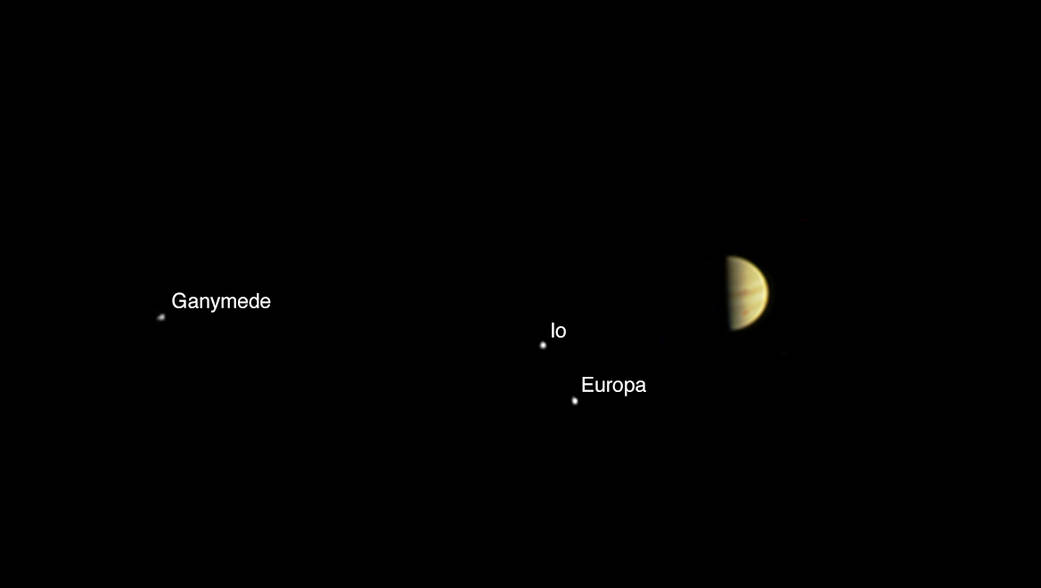
PASADENA, California — NASA's Juno probe has just given humanity a new perspective on the cosmos.
In the weeks leading up to the spacecraft's arrival at Jupiter Monday night (July 4), Juno captured a stunning video of the four Galilean moons — Callisto, Europa, Ganymede and Io — circling the giant planet in a first-of-its-kind view of celestial dynamics.
"In all of history, we've really never been able to see the motion of any heavenly body against another," Juno principal investigator Scott Bolton said Monday night during a news conference here at NASA's Jet Propulsion Laboratory after Juno's successful arrival. [Juno Spacecraft's July 4 Jupiter Arrival: Complete Mission Coverage]
"This is the king of our solar system and its disciples going around it," added Bolton, who's based at the Southwest Research Institute in San Antonio. "To me, it's very significant, because we're finally able to see — with real video, with real pictures — this motion, and we've only been able to imagine it up until today."
The Juno video is a shout-out of sorts to one of history's greatest scientists. In 1610, famed Italian astronomer Galileo Galilei discovered the moons subsequently called Galilean, and he deduced from their movement over the course of multiple nights that they orbit Jupiter
"It was a revelation, and it changed our culture and our perspective of ourselves forever: Earth was not the center," Bolton said just before unveiling the video.
"He imagined this, and after that, for centuries, we have imagined how the planets move and how the stars move, and we've only been aided with computer animation or the efforts of Hollywood," Bolton added. "Well, tonight that's going to change."
Get the Space.com Newsletter
Breaking space news, the latest updates on rocket launches, skywatching events and more!
The video is composed of images Juno took with its JunoCam instrument between June 12 and June 29, as the spacecraft closed the distance to Jupiter from 10 million miles (16 million kilometers) to 3 million miles (5 million km), NASA officials said.
Other dramatic visuals should be in the offing; Bolton said the Juno team plans to capture another video as the spacecraft loops back around toward another close approach of Jupiter in late August. (Juno was captured Monday night into a highly elliptical 53-day orbit; in October, the probe will perform another engine burn to shift over to its 14-day science orbit. Juno will then study Jupiter's composition, interior structure, and magnetic and gravitational fields in detail through February 2018.)
The $1.1 billion Juno mission launched in August 2011. The probe's observations should help scientists better understand the origins of Jupiter and, by extension, the solar system's early days, mission team members have said.
Follow Mike Wall on Twitter @michaeldwall and Google+. Follow us @Spacedotcom, Facebook or Google+. Originally published on Space.com.
Join our Space Forums to keep talking space on the latest missions, night sky and more! And if you have a news tip, correction or comment, let us know at: community@space.com.

Michael Wall is a Senior Space Writer with Space.com and joined the team in 2010. He primarily covers exoplanets, spaceflight and military space, but has been known to dabble in the space art beat. His book about the search for alien life, "Out There," was published on Nov. 13, 2018. Before becoming a science writer, Michael worked as a herpetologist and wildlife biologist. He has a Ph.D. in evolutionary biology from the University of Sydney, Australia, a bachelor's degree from the University of Arizona, and a graduate certificate in science writing from the University of California, Santa Cruz. To find out what his latest project is, you can follow Michael on Twitter.









